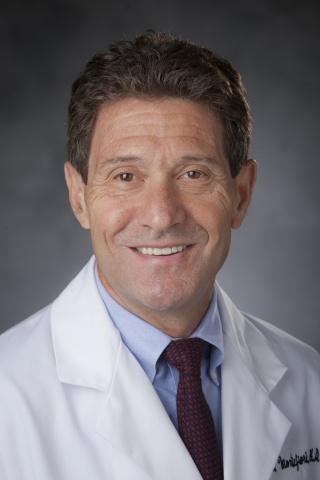
The Collaboration for AIDS Vaccine Discovery (CAVD) awarded a $32.6 million grant to David Montefiori, PhD, Professor of Surgery, Division of Surgical Sciences, to lead an international consortium that will assess immune responses elicited by candidate HIV vaccines. The CAVD is an international network of scientists founded by the Bill and Melinda Gates Foundation in 2006 to accelerate the development of an HIV vaccine.
The 5-year grant funds the Comprehensive Antibody Vaccine Immune Monitoring Consortium (CAVIMC), a central service facility that performs standardized testing of antibody responses to HIV vaccines designed by CAVD investigators. Under the direction of Dr. Montefiori, the CAVIMC program has received more than $100 million in funding over the previous 10 years. New scientific findings generated by the program help bridge the gap between preclinical research and human clinical trials.
Overcoming Obstacles to an HIV Vaccine
According to the Joint United Nations Programme on HIV/AIDS (UNAIDS), approximately 35 million people have died from AIDS-related illnesses since the epidemic began over 30 years ago. In 2015, 36.7 million people were living with HIV, and 2.1 million became newly infected. While antiretroviral treatments have drastically improved, a vaccine may offer the best hope of stopping the spread of the virus and controlling the epidemic.
In 2009, the RV144 HIV vaccine trial in Thailand energized the field after demonstrating a 31% efficacy in preventing HIV infection.
“The outcome of the RV144 trial indicated that protection against infection was possible,” says Dr. Montefiori. “It is very exciting to have that positive signal in efficacy trials. It is the first and only time we have had a positive signal, and from studying the immune responses, we have some idea of what types of responses were protective, which will guide the design of improved vaccines that will elicit even better responses of that kind.”
Researchers face many challenges in developing an HIV vaccine. The HIV virus is an unprecedented adversary that evolved to evade host immune responses and fortify a stronghold in the body.
“Once the virus infects a person, it integrates its genetic material into the cell and establishes a persistent infection that you cannot get rid of,” Dr. Montefiori explains. “You have to be able to prevent infection all together. Preventing disease in this case is a much higher hurdle than it is for other viruses because we cannot just kick the virus out.”
“The virus is highly variable at the genetic level. It can tolerate a lot of changes in its genetic makeup and still be viable and pathogenic,” says Dr. Montefori. “But that also allows the virus to change a lot to evade antibodies and that is how the virus has evolved. It is very adaptable. We have to find regions of the virus that are conserved, that cannot change, and target those regions of vulnerability with a vaccine.”
Inducing the Right Antibody Responses
Current vaccine efforts in the CAVIMC target two types of antibodies: neutralizing and non-neutralizing. Broadly neutralizing antibodies, or bNAbs, are considered the “holy grail” of HIV vaccine development because they can neutralize over 90% of circulating HIV strains, a major goal in overcoming the high genetic diversity of the virus.
The CAVD currently has several human clinical trials underway to test passively administered bNAbs for protection against HIV infection. Dr. Montefiori’s team performs the centralized work to measure the antibody levels in vaccine recipients and to determine how well the bNAbs protect. His team also identified the best combinations of bnAbs predicted to afford optimal protection.
“This is another exciting area in the field. We have these very good broadly neutralizing antibodies that are isolated from infected persons and manufactured as monoclonal antibodies. Now it is a safe, pure antibody that you can make in the laboratory and in production plants in high quantities and then inject into people. You are giving people what you want the vaccine to induce,” Dr. Montefiori says.
Surprisingly, non-neutralizing antibodies protected against HIV infection in the RV144 trial. Before the trial, neutralizing antibodies were thought to be the only immune mechanism that could prevent infection. CAVIMC member Georgia Tomaras, PhD, Professor of Surgery, Division of Surgical Sciences, and investigator at the Duke Human Vaccine Institute, studies the binding activity and biological functions of non-neutralizing antibodies with the goal of designing HIV vaccines with immunogens that will bind to these antibodies.
CAVIMC member Guido Ferrari, PhD, Associate Professor of Surgery, Division of Surgical Sciences, investigates the role of antibody-dependent cellular cytotoxicity (ADCC) in preventing HIV infection. ADCC activity recruits natural killer cells to destroy the virus, and this immune response may be exploited by an HIV vaccine. Marcella Sarzotti-Kelsoe, PhD, Research Professor of Immunology, heads the CAVIMC’s Quality Assurance Unit to ensure that the work is performed in Good Clinical Laboratory Practice (GCLP).
Collaborators
Other collaborating institutions in the CAVIMC include Beth Israel Deaconess Medical Center, Harvard Medical School, The Ragon Institute, Massachusetts General Hospital, Dartmouth College, the University of Alabama at Birmingham, the New Mexico Consortium, the University of Cape Town, the National Institute for Communicable Diseases in Johannesburg, South Africa, and the Fraunhofer Institute for Biomedical Technology in Sulzbach, Germany.